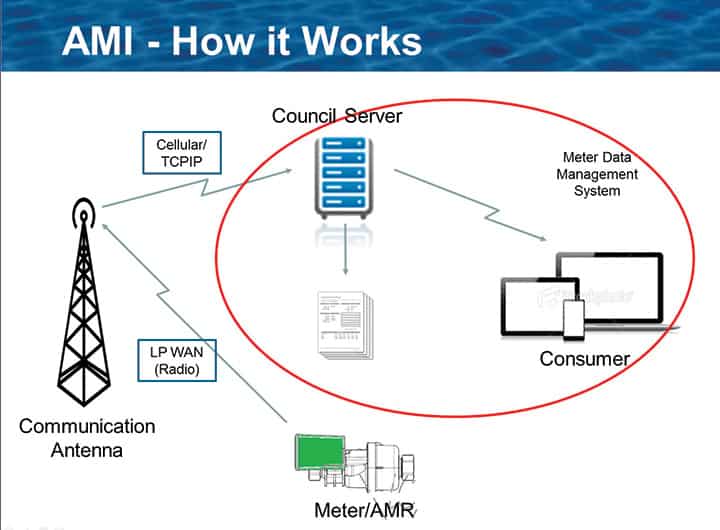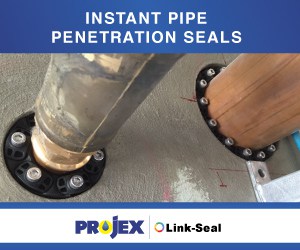The Internet of Things (IoT) is shaping up to have a critical influence over how water businesses operate now and into the future. With continued advancements being made in both sensor and communications technologies, capturing highly-detailed information is becoming a lot more cost-effective. With more data being captured more frequently, there has never been a greater need find innovative analytical techniques to manage the increasing data load.
The water and waste services (WWS) department at Mackay Regional Council (MRC) recently embarked on a project to transform the operations of its water business using IoT technologies.
The transformation came about when WWS was required to respond creatively to the challenges and impacts of a rapid increase in population, requiring significant investments in capacity expansion, which in turn resulted in unsustainable increases in water tariffs.
The cornerstone of the revised strategy was to focus on non-capital solutions to address the growing demand and the resulting impacts on existing treatment and distribution capacity. One aspect of this approach was a demand management program with a target of reducing daily per capita consumption by 10 per cent.
Unlike in the electricity industry, water utilities have the advantage of network storage capacity. As such, managing intra-day peaks is not a significant issue.
What consumes the treatment capacity is the daily demand during the dry season. Given the climatic environment in Mackay, daily water demand peaks during a period of 8 to 12 weeks in the late spring-early summer, when there is a dry period with minimal rainfall in the region.
Given this demand pattern and the resulting impact on capacity, the core focus of the demand management program was outdoor water use, which was intuitively known as the key driver of the increase in demand for water during the dry season.
Preliminary studies undertaken indicated that a 10 per cent reduction in peak demand had the ability to delay the construction of the next treatment plant by around four to five years. Such a deferral of capital investment would yield savings only on cost of funds of around $20 million.
A key element of the demand management program was to develop a solid understanding of the consumption behaviours of the Mackay population. From this, it could be determined how this impacted the output of the treatment plants and therefore capacity utilisation.
As with most water utilities, while Mackay has suitable SCADA systems in place within its treatment facilities, there was very little information captured once the water left the treatment plant. The only information on consumption patterns came through twice-yearly meter reads, which did not provide anywhere near the granularity needed to analyse and understand consumer behaviour patterns.
Finally, MRC was also aware that it had approximately 15 per cent network losses, which while within national averages, was still a significant figure.
Attributing causes to these losses and attempting to locate leaks (which are usually a significant cause of network losses) is almost impossible without detailed information that identifies when and where the losses are occurring.
Accessing detailed information in a cost-effective manner was identified as an important prerequisite to achieving the identified demand management goals.
Mackay adopted a two-pronged strategy which involved installing an automated metering infrastructure (AMI) network to capture and analyse detailed demand data, and launching a comprehensive social marketing program.
AUTOMATED METERING INFRASTRUCTURE
The key challenge in delivering on the requirement to capture detailed consumption data was to be able to do it in a cost-effective manner that enabled the establishment of a viable business case.
A standard domestic water meter is a low-cost device (usually less than $50/-) and generates a limited amount of revenue (in the case of Mackay, on average around $350-$450 per annum).
In order to deliver the project within the cost parameters, Mackay partnered with a relatively unknown Australian start-up based in Sydney that was deploying an emerging communications technology that is now beginning to gain traction under the name Low Powered Wide Area Networks (LPWAN).
It is essentially a low-frequency (and therefore long-range) radio network, capable of transmitting limited quantities of data at very low power consumption rates. In order to keep initial investments low, MRC worked with the technology provider to strip out all unnecessary functionality.
One key decision was to go with a one-way communications capability, which significantly reduced the power requirements and therefore the lifetime total costs of installing and operating a device.
Given the high-tech nature of the communications network, MRC decided to procure the communications as a service (similar to how one would buy phone services), requiring the technology supplier to own and operate the network. This also transformed the costs of communications from a capital cost to an ongoing operational cost.
After almost two years of gradually expanding trials (and several iterations of the AMR devices), MRC made the decision to install AMR devices on its entire meter fleet of 40,000+ meters.
The network generates hourly meter reads from each meter, which enable a range of analytics to be performed on the data (see Figure 1).
An integral component of the AMI project was the development of a meter data management (MDM) system designed to collect and interpret the large quantity of data that was being generated through the AMI network and to convert that data into actionable insights.
Prior to the installation of the AMI network, Mackay was generating approximately 80,000 meter reading records per year (40,000 meters x two meter reads per year).
After the AMI installation, the comparative figure is 292 million meter read records per year (40,000 meters x 20 average meter reads per day x 365 days per year). Mackay now generates ten times more meter read records per day than it previously did in a year.
The MDM system, which was branded MiWater, has a number of functionalities built in, to enable a water utility to use the meter data for a range of activities and decisions (see end of story for a listing of the MiWater functionality).
A key element of MiWater is the customer portal, which enables a utility to permit its customers to access the detailed consumption information. Access to such information has proven to be a strong enabler of behavioural change.
In a departure from the normal approach to building websites, the portal is designed not to encourage hits, but to limit the number of hits. This is achieved through the alerting and automated reporting functionality through which customers can decide the reports they receive, and customise their alerts.
As a result, customers do not have to visit the site except to further investigate the occurrence of an exception event. The customer portal is built in a manner that enables water utilities to completely customise the look and feel of the interface, so that it integrates seamlessly with their existing branding, messaging and online presence.
Using the consumption data generated through the AMI network and combining that with the property profile information obtained through the customer portal, MRC has been able to build highly-targeted communication and educational campaigns aimed at preventing leaks and addressing outdoor water consumption.
SOCIAL MARKETING CAMPAIGN
The other prong of the strategy was the deployment of a five-year social marketing campaign, which was developed based on the information gathered through a fairly extensive customer survey process.
The survey indicated that only a very small percentage of customers (single digit) identified water as a burning issue for Mackay, and very few customers had any understanding of the impact of infrastructure requirements on the rising cost of their water bills.
On the plus side, a large percentage of customers identified the need to conserve water, conceded that they could be doing more in that direction, and agreed that MRC had a role to play in driving water conservation efforts.
Based on this information, the initial phase of the campaign focused on building awareness in the community of water as an important and urgent issue.
The key challenge here was that Mackay, being in a tropical region, had no immediate shortages of water. The shortages were in the process and distribution capacities, which were largely invisible to the average consumer.
To address this dichotomy, the awareness campaign was built around the theme “wasting water wastes a whole lot of opportunities”, which attempted to convey the link between high investments and high water prices.
The second and third years of the campaign focused on building awareness of the impact of outdoor watering, which was supplemented by educational messages of best practice outdoor water use.
Here the slogan “Watch the flow of your H2O” was used alongside imaging of outdoor water use. The best practice approach was further reinforced with water restrictions that directed the customers to use water at optimal times and manners.
Having primed the customers for behavioural change, the next phase focused on providing the tools to enable the customers to undertake that change. Initiatives such issuing of tap timers were undertaken to try and bring some discipline into the outdoor watering process.
By this stage, most of the residential properties were fitted with advanced meter reading (AMR) devices and the leak detection algorithms within MiWater were already detecting customer-side leaks and alerting customers on a periodic basis. The next step was to launch the public portal which was branded “myh2o”.
In order to generate participation, the launch was accompanied by a marketing campaign and a sign-up competition with over $7,000 in prizes. The initial launch delivered a 15 per cent residential sign-up rate which has since climbed to around 30 per cent.
The final phase of the campaign, which is currently underway, has the objective of reinforcing the new behaviours and converting them into permanent habits. To further drive registrations on the customer portal, the campaign contains customer testimonials on how the site helps everyday citizens to save water and save money.
THE RESULTS
Currently, MRC is in the process of installing AMR devices on its last batch of around 2,000 meters, predominantly larger-sized commercial connections. The MiWater system is being extensively used in a range of functions.
During the last year, MRC on average has been sending out around 1,500 leak notifications to its customers. The average duration of a leak has come down from over 150 days to around 60 days. With around 2.5 per cent of the properties having a leak at any given time, the reduction in the average duration is expected to contribute towards lower consumption.
The nature of consumer engagement has also changed significantly. The communications have changed from mass market generic messages to targeted messages to specific consumer segments.
Since the initial conception of this project, Mackay, like the rest of Australia, and the rest of the world, has seen some significant changes in its economic environment and, as a result, in its current and projected population growth.
Even after adjusting for this lower growth, the demand management program has seen Mackay exceed the targeted 10 per cent reduction in its water consumption. Average per capita residential consumption is down from around 240 litres per person per day (L/d) to around 210L/d, a reduction of just over 12 per cent.
The new water treatment plant, which in 2010 was slated for 2020, is now, as per the latest long-term financial plan, pushed back to 2032.
As indicated earlier, one factor enabling that deferment is the lower population growth predictions, but lower consumption rates have been a significant contributor as well.
This deferment is part of an overall reduction in the ten-year capital program by 30 per cent, driven primarily by lower population growth predictions, demand management initiatives and a revised approach to the development of the capital program with a much greater emphasis on exploring non-capital solutions, with capital expenditure planned only as a last resort.
The deferment of capital expenditure and the resulting savings in operational expenditure has resulted in a notable reduction in the forward price path of both water and sewer tariffs.
In comparison to the price path adopted in 2010/11, the most recent price path shows an average residential consumer in Mackay will pay approximately $400 per annum less for water by 2025. Both water and sewerage prices have been held steady (zero percent increase) for the last two years with another year of no increase planned.
Much is left to do. Currently MRC is in the process of establishing the on-ground facilities, such as properly located network bulk flow meters, to implement its DMA monitoring program with a view toward eliminating at least half of its current non-revenue water.
MRC is also currently exploring how it can leverage its already established communications network to monitoring its sewer network. Preventing dry weather overflows and better understanding the inflow and infiltration profiles within each of its catchments are two key objectives.
MiWater functionality
- Receive & process data from AMI network
- Establish dashboards for each individual meter, property, and water account
- Algorithm for automatic detection of customer-side leaks
- Automated generation of alerts as emails, text messages or letters
- CRM functionality to track all communications to customers
- Customer-profiling analytics
- Communications network monitoring to identify maintenance requirements and enforce contractual KPIs
- Tablet application to manage the process of installing, changing and decommissioning meters and AMR units
- Tablet application to conduct meter reading and meter read audits
- Establish and manage district metered areas (DMAs), track consumption & water losses and chart diurnal patterns
- Comprehensive database of meter and AMR manufacturers, makes and models with related technical data
- Capability to spatially map meters/AMRs, leaks, and communications status
- Comprehensive data interrogation capabilities
- Establish and manage sub-metering networks on behalf of large-scale property developments (high rise apartments, shopping complexes)
- Integration capabilities to receive data from customer/property systems and asset management systems
- Integration capability to provide data to billing systems and asset management systems
- Advanced customer portal to enable customers to access their detailed water consumption records and set customised alerts
- A range of reporting functionalities
- User and security management
1 In 2011 it was estimated that based on then consumption patterns and population growth estimates, the current treatment plant would reach capacity by 2020. Due to space constraints at the location of the current treatment plant, the only viable option identified was to build a new second treatment plant in a greenfield location. The capital cost of a new treatment plant including raw water pipelines was estimated at around $100 million in current cost.
2 With the exception of some information from a few reservoirs and pump stations that were SCADA-enabled.
3 While the reads are set at around one read per hour, overall it averages to around 20 meter reads per meter per day.
To learn more about the AMI project at MRC, or the MiWater software, please contact Stephen Fernando at [email protected].














